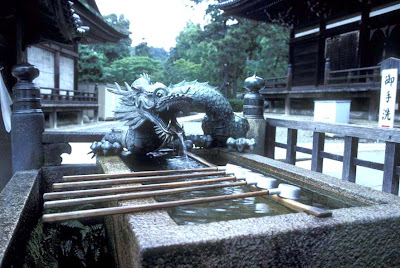 |
| Alcatraz. Tunnel and Guard Tower at Entrance to Prison Area. |
I’ve been visiting the San Francisco Bay area for more than forty years, and every time I cross the Golden Gate Bridge on my way to Marin County I look to my right and see the tiny island of Alcatraz, with its infamous prison that once housed feared felons such as Al Capone and the "Birdman of Alcatraz”. Finally, a few weeks ago, on an unusually warm and sunny December day, I went there with my family. In the early days Alcatraz was a lighthouse and a military base. Then it was a prison. Now it is a
national park. The prison closed in 1963 after twenty-nine years as a federal penitentiary and since 1973 tours have provided the chance to visit and learn some of the island’s history.
 |
| Boarding the Ferry in San Francisco |
Our tour began at Pier 33 in San Francisco (near Fisherman’s Wharf) where we caught the Alcatraz ferry. After a short ride (about 20 minutes) we landed at the Alcatraz dock where a park ranger introduced us to the island. After that we were on our own to explore, entering the prison area through the sally port, or secure tunnel.
 |
| Building 64, once apartments for families of prison staff. The "Indians Welcome" sign is from the island's occupation by Native Americans 1969-70. |
We started with a video and exhibits in Building 64--a good place to spend your time on a day when the weather is not so fine as it was for us. (San Francisco Bay is famous for its wind and fog and it was easy to appreciate how miserable life would have been for prisoners in their drafty unheated cells atop the “rock” on cold winter days.) We then trudged up the hill to the cell block where we picked up our earphones for the audio tour (included in the price of the tour ticket.)
In preparation for our trip, I and all the kids in the family (ages 8, 10 and 12) read Gennifer Choldenko’s book
Al Capone Does My Shirts, a fictional story set in the 1930s during the time that families of the prison staff lived on the island. Prisoners did the laundry for everyone on the island--thus the possibility that Al Capone, who was an inmate from 1934 to 1938, personally washed the family's clothes. (
Al Capone Shines My Shoes and
Al Capone Does My Homework by the same author are also set on Alcatraz.)
 |
| View of Alcatraz from Pier 39 in San Francisco |
As we walked around the island the story came to life as we passed the apartments where people lived and the dock where children caught the boat each day to go to school on the mainland. At the top of the hill we passed the remains of the warden’s house. Like many of the buildings on the island, it burned after the prison was closed and was never rebuilt.
The audio tour of the cell block was excellent, directing us through the building with stops at critical points to tell about prison life. The narration is by former prison guards. Several cells were furnished as they would have been–with a narrow bed, toilet and simple table and shelf. We also visited the dining hall–meals lasted 20 minutes–and what had been the prison library. Apparently philosophy books were among the most popular.
 |
| Prison library. Books were delivered to inmates. |
A few days before our trip to Alcatraz we watched the movie
The Birdman of Alcatraz starring Burt Lancaster. It is the true story of Robert Stroud, whose book on bird diseases, based on his study of birds while in prison in Leavenworth, Kansas, is still the definitive book on the subject. As it turns out, though, he never had birds at Alcatraz. Stroud came to Alcatraz in 1942 and stayed there until 1952 when he was transferred to a medical facility for federal prisoners in Springfield, Missouri.
 |
| Alcatraz lighthouse, built in 1854--the first lighthouse on the West Coast. Ruins of the Warden's house are on left. The city and Bay Bridge are in the distance. |
The audio tour ends near the patio outside the administration building in front of the lighthouse, where there is a spectacular view of the city of San Francisco and the Bay Bridge and Golden Gate. But for prisoners confined to life inside their tiny cells, that view must have seemed a million miles away.
 |
| Aerial photo of Alcatraz displayed in the gift shop. |
Tour information is available at
Alcatraz Cruises, the official government concessioner for visits to the island. Tickets usually sell out days in advance, especially during vacation periods so it is important to plan ahead. I bought our tickets about a month ahead of time. Find out more about Alcatraz from the
National Park Service website.
 |
| The cell house had three tiers of individual cells. |
Did anyone escape from Alcatraz?
In its 29 years as a prison, 36 prisoners tried to escape; all but five were recaptured or accounted for. Three who were unaccounted for participated in the same breakout, the June 1962 escape, immortalized in the movie
Escape from Alcatraz with Clint Eastwood.
Golden Gate National Recreation Area
Alcatraz Island is just one part of the breathtaking Golden Gate National Recreation Area, one of the largest and most visited urban National Parks in the United States.
Other "Must See" Spots of the Golden Gate National Recreation Area:
Fort Mason Center
Marin Headlands
Crissy Field
Presidio
Fort Point
Muir Woods (see my post on this blog for 12/26/11)
Sweeney and Milagra Ridges and Mori Point
Fort Funston
San Francisco National Maritime Historic Park
Support your National Parks
Get involved and preserve their beauty by visiting America’s National Parks
http://www.parksconservancy.org
























